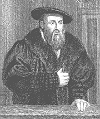 Johannes Kepler
Johannes Kepler Johannes Kepler
Johannes KeplerAt the age of 24, Kepler published Mysterium cosmographicum (Cosmographic Mystery, 1596), in which he defended the Copernican theory and described his ideas on the structure of the planetary system. Influenced by the Pythagoreans, Kepler viewed the universe as being governed by geometric relationships that conform to the inscribed and circumscribed circles of the five regular polygons.
Although he was not a Copernican himself, Tycho Brahe, the mathematician at the court of Emperor Rudolph II at Prague, was so impressed with Kepler's work that in 1600 he invited Kepler to come to Prague as his assistant. Confronted with the Catholic persecution of the Protestant minority in Graz, Kepler gladly accepted. When Brahe died the following year, Kepler was appointed his successor and thus inherited Brahe's scientific legacy.
This legacy included many accurate positional determinations of the planets, especially those of Mars. Kepler now embarked on an intensive study of the true orbits of the planets. Abandoning the ancient belief that the planets must move in perfect circles, Kepler concentrated on Mars. He proved that the orbit of Mars is an ellipse, with the Sun occupying one of its two foci. This, the first of Kepler's laws of planetary motion, appeared in Astronomia nova (New Astronomy) in 1609, with the second "law of areas" governing planetary velocity.
Always guided by the concept of beauty in the structure of the universe, and specifically by a theory of harmony in geometric figures, numbers, and music, Kepler, in his Harmonices mundi (Harmonies of the World, 1619), announced his third law--a relationship between the orbital periods and the distances of the planets from the Sun. His belief that the Sun regulates the velocity of the planets was a milestone in scientific thought, laying the foundation for Newton's theory of universal gravitation.
Among Kepler's numerous scientific contributions are an influential treatise on the theory of optics (1604), a treatise on optics as applied to telescope lenses (1611), a work offering physical explanations of the appearance of a nova in 1604, and an enthusiastic acceptance of and elaboration on Galileo's observations with a telescope (1610). His Epitome astronomiae Copernicanae (Introduction to Copernican Astronomy, 1618-21) became one of the most widely read treatises on astronomy in Europe. Kepler's last great work, known as the Rudolphine Tables (1627), was a widely used compilation of accurate tables of planetary motion.
The posthumous Somnium (Dream, 1634), on which Kepler labored until shortly before his death, is indicative of his fertile mind. In this work, Kepler describes a journey to the Moon and discusses the existence of lunar inhabitants. A crucial link between the thought of Copernicus and that of Newton, Kepler was an important figure in the 17th-century scientific revolution.
